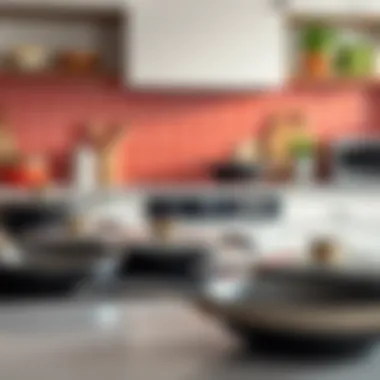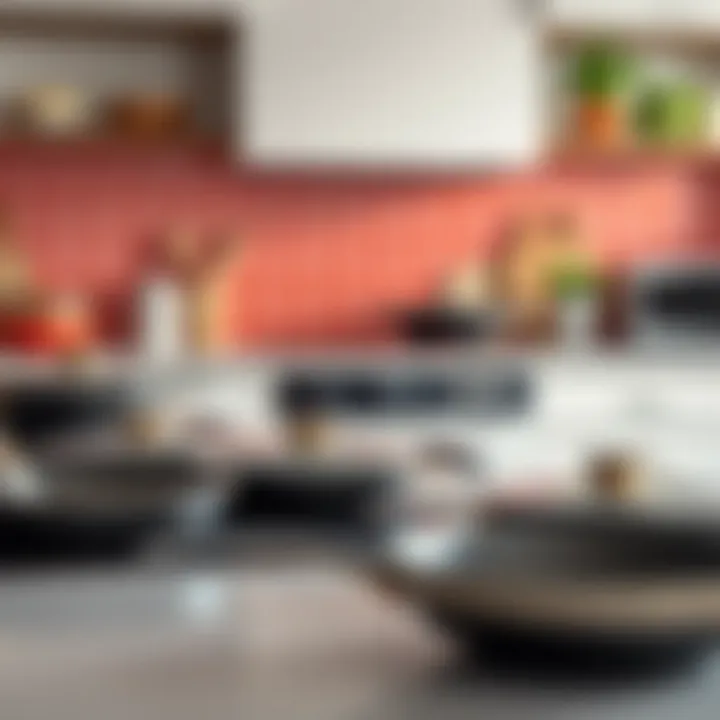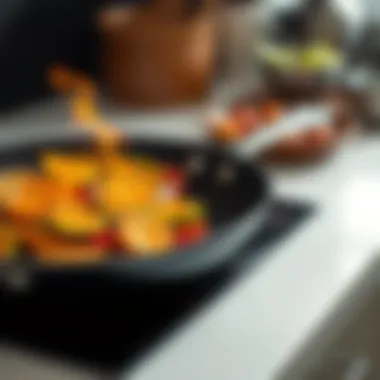Affordable Induction Pans: Performance and Value


Intro
In the ever-evolving landscape of kitchenware, affordable induction pans stand out as a blend of performance and value. As modern culinary enthusiasts seek tools that not only enhance cooking but also resonate with taste and style, the importance of choosing the right cookware becomes paramount. With induction cooking gaining traction, understanding how to select budget-friendly options that do not skimp on quality will better equip homeowners and cooking aficionados alike.
Induction pans are designed to work with magnetic surfaces, making them an energy-efficient choice. Not only do they heat up quickly, they also offer precise temperature control for the discerning chef. But affordability doesn't have to equate to quality compromise. It's crucial to assess different models, considering factors like materials, design, and usability. This guide aims to demystify induction cookware, leading readers through the essential considerations for making informed decisions.
Understanding Induction Cooking
Understanding the intricacies of induction cooking is vital, especially for those who consider upgrading their kitchen without breaking the bank. Induction cooking has surged in popularity in recent years due to its efficiency and modernity. As homeowners increasingly lean towards energy-efficient appliances, grasping how induction heating works can clarify why affordable induction pans are a valuable addition to any kitchen. Knowing the science behind this cooking method enhances the decision-making process for consumers who seek to balance quality and cost.
The Science Behind Induction Heating
Induction cooking employs electromagnetic energy to directly heat pots and pans, rather than relying on an open flame or electric heating elements. When an induction-compatible pan is placed on the cooktop, an electromagnetic field generates heat within the pot itself. The method is quick and energy-efficient, as there’s minimal heat loss.
This technology often leaves users wondering if it's worth the investment. The answer often lies in understanding the performance benefits that induction can bring to the table—quite literally.
Advantages of Induction Cooking
Induction cooking's benefits, particularly in conjunction with affordable induction pans, warrant a closer look. Here are the key advantages that make it an attractive option for any culinary enthusiast:
Efficiency and Speed
When it comes to efficiency, induction cooking reigns supreme. The heating process is astonishingly rapid. For example, it takes about half the time to boil water compared to gas or electric methods. This is particularly vital for busy homeowners looking to whip up meals in a pinch. Who wouldn’t want dinner on the table faster?
Another standout characteristic of efficiency is energy savings. Since induction cooktops heat the cookware directly, less energy is wasted heating the surrounding air. It's a good deal for both the planet and your wallet.
Safety Features
Safety is often a top concern in any kitchen. With induction cooking, the cooktop itself remains cool to the touch shortly after the pan is removed, significantly reducing the risk of burns. This feature alone makes it appealing for families with young children. A high-quality induction pan can also elevate this safety aspect, ensuring that it won’t warp under high heat. Moreover, many induction stoves possess built-in timers and automatic shut-off features, which contribute to a worry-free cooking experience.
Temperature Control
Induction cooking allows for precise temperature control, making it a favorite among seasoned cooks. Unlike traditional methods where adjusting the heat may take time to reflect on the food, induction responds instantly. This quick feedback enables better cooking outcomes, especially for dishes requiring specific temperatures—hello, delicate sauces.
On the flip side, this might be a learning curve for those new to it. Being used to traditional cooking methods can make adjusting to induction strkingly different, which might be frustrating at first.
Defining Affordable Induction Pans
Defining affordable induction pans is pivotal in our exploration of not just their construction but their practicality in everyday cooking scenarios. With the surge in popularity of induction cooking, budget-conscious consumers need clarity about what constitutes an affordable option. While the marked price brings to mind thoughts of savings, it’s essential to understand that ‘cheap’ doesn’t mean cutting corners in quality, especially in cookware that significantly impacts culinary performance. This discussion encompasses materials, construction, and features that maintain culinary excellence without breaking the bank.
What Classifies as 'Cheap'?
When considering what qualifies as ‘cheap,’ it’s important to focus on the balance between price and essential features. For instance, many induction pans hail from brands that prioritize affordability but compromise little on performance. A general rule of thumb is to look for induction pans priced below $50, demonstrating a competitive edge yet maintaining good quality and user satisfaction.
This classification also involves understanding how different manufacturers apply cost-saving measures while not sacrificing critical aspects like durability or design. Creating value at a lower price point often means using innovative materials or streamlined manufacturing processes, contributing to budget-friendly options that still perform well in the kitchen.
Materials Used in Budget-Friendly Options
The materials that go into budget-friendly induction pans play a significant role in their overall effectiveness and durability. Here are some common materials:
Stainless Steel
Stainless steel stands out due to its exceptional corrosion resistance and durability. One notable characteristic is its ability to withstand high temperatures. This feature is particularly beneficial for those venturing into serious culinary tasks, ensuring even cooking and longevity. The unique feature of stainless steel is its magnetic base, allowing it to work seamlessly with induction cooktops. However, it may not offer the best non-stick performance, which is something to consider, especially for those who prefer easy clean-up. Despite this drawback, many home chefs gravitate towards stainless steel for its sturdiness and aesthetic appeal, striking a fine balance between quality and price.
Non-Stick Coatings
Non-stick coatings have carved a niche in the cooking world, primarily for their convenience. An appealing characteristic here is the ease with which food can be released from the surface, making it a favorite among busy cooks or those new to the kitchen. The key selling point of non-stick pans is their ability to require less oil or fat, promoting healthier cooking methods.


However, budget options with non-stick coatings can vary widely in quality. Cheaper versions may wear down after a short time, raising concerns over durability and safety. It's vital to check for PFOA-free labels and other safety indicators to ensure you are not unwittingly trading health for affordability. While these pans often fare well in the initial stages, users should monitor their condition and consider replacements regularly to ensure ongoing performance.
Cast Iron
Cast iron is another formidable contender in the realm of budget-friendly cookware. Renowned for its heat retention and even cooking, cast iron pans can develop incredible non-stick properties when seasoned well. A crucial aspect is their versatility; they can transition from stovetop to oven with ease, broadening culinary capabilities.
One of cast iron’s unique selling points is its ability to improve with age, as seasoned pans tend to perform better over time. However, weight can be a drawback, as these pans can be hefty, and some users might struggle with handling them. As a more affordable long-term investment, cast iron cookware is often seen as a staple in households that value durability and functionality. Though they may require a bit more care in maintenance, their performance in various cooking situations is generally worth the effort.
Understanding these materials helps demystify the characteristics of affordable induction pans, allowing consumers to make informed decisions that prioritize quality, longevity, and overall cooking experience.
Features to Look for in Cheap Induction Pans
When diving into the world of induction cooking, selecting the right induction pan can be quite testy. While affordability is key, there are essential features that should not be overlooked. A well-crafted induction pan not only ensures seamless cooking but can elevate the entire kitchen experience. Let’s discuss the paramount features to consider when searching for that perfect, budget-friendly induction pan.
Compatibility with Induction Stoves
First and foremost, a pan must be compatible with induction stoves. It’s like trying to fit a square peg in a round hole if your cookware isn’t designed for induction. Induction cooking relies on magnetic fields to heat up the cookware directly. This means a pan must have a magnetic base, typically made of cast iron or specific stainless steel blends. Many manufacturers provide a symbol or label indicating induction compatibility, so keep a keen eye. Plus, some pans may work best on certain induction models, so it’s useful to consult your stove's manual if all else fails.
- Tip: Use a magnet as a quick compatibility test. If it sticks, you’re good to go!
Durability and Sturdiness
In the world of cookware, durability can make or break your investment. Cheap doesn’t mean flimsy; a sturdy induction pan should withstand the rigors of daily cooking without warping or scratching easily. Ideally, an induction pan will feature thicker walls and bases to ensure even heat distribution and reduce the chance of hot spots. Materials such as heavy-duty stainless steel or enameled cast iron generally offer superior durability.
- Signs of Quality: Look for reinforced edges and a well-sealed non-stick surface; these characteristics can extend the life of your pan significantly.
Weight and Handle Design
A careful balance is required when considering the weight of an induction pan. While a heavy pan often means better heat retention and stability, it can become cumbersome, impacting ease of use. Aim for a pan that’s hefty enough to stay put on the burner but not so heavy that you feel like you’re lifting weights each time you cook.
The handle design also plays a vital role. A comfortable, well-designed handle can make the difference between a confident cooking session and a messy mishap. Look for handles that are ergonomically shaped and heat-resistant, allowing for secure, steady control even during high-heat cooking.
"The right balance between weight and handle design can turn an average cooking experience into a pleasing one."
As you seek out budget-friendly options, remember that the characteristics mentioned above can greatly influence cooking performance and pleasure in the kitchen. Keeping these features in mind will not only save you some dollars but also enhance your culinary adventures.
Top Affordable Induction Pan Brands
When diving into the realm of induction cooking, it's crucial to pay attention to the brands that offer affordable yet reliable induction pans. The selection of a brand can deeply influence your cooking experience, the longevity of the cookware, and how well it performs on your induction stove. In a world where kitchenware options are as plentiful as grains of rice, narrowing it down to the right brands helps ensure that you’re not just throwing money into a bottomless pit.
Brand Reputation and Reliability
Brand reputation is more than just a catchy logo or a flashy advertisement. It embodies trust, transparent customer service, and proven history behind the products. Reliable brand names often provide peace of mind; you can expect certain standards in their offerings. When it comes to induction pans, a reputable brand typically invests in quality materials and robust construction.
- Consumers have a wealth of feedback accessible through platforms such as Reddit or consumer review sites.
- Look for brands that prioritize customer service; it showcases a willingness to stand behind their product.
- Warranty options are often a telltale sign of brand confidence—more extended warranties usually reflect a higher-quality product.
Buying from well-established brands often guarantees that you’re getting a product that's been tested by thousands, sometimes millions, before making its way to your kitchen. On the flip side, lesser-known brands may pull you in with lower price tags but often at the cost of reliability.
Some of the notable brands to consider include T-fal, Cuisinart, and Circulon, which have generally maintained a solid reputation for providing good affordable options without major compromises in performance. These brands ensure that you can whip up a meal without the fear of your pan failing midway through.
Innovative Budget Options
In the quest for value, innovative solutions come to the forefront. Many brands are now competing not just on price but with unique features that enhance usability in the kitchen. Budget-friendly doesn’t have to mean basic.


- Look for induction pans with ergonomic handles that make cooking less of a chore and more of a joy. It’s those little touches that make a big difference.
- Multi-ply construction, often found in budget options from reputable brands, can improve heat distribution, mimicking some of the more expensive alternatives.
- Brand offerings like GreenPan focus on eco-friendly cooking surfaces, giving consumers healthier choices at an affordable price.
These advancements are encouraging for consumers looking to invest wisely. With competition pushing creativity, even budget-friendly options are showcasing features once limited to expensive cookware. You can equip your kitchen with functioning, durable, and aesthetically pleasing pans without breaking the bank.
In summary, paying attention to brand reputation and innovative features can guide your purchasing decisions when selecting an induction pan. Navigating the myriad options available becomes more manageable when you remember that not all cheap brands are created equal. Be diligent, stay informed, and you’ll find an induction pan that serves you right and fits your budget.
Comparing Cheap Induction Pans to Higher-End Models
When you think about induction cooking, it's easy to be drawn to those high-end pans that seem to shine bright like a new penny. However, understanding the difference between cheap induction pans and their pricier counterparts is crucial for anyone looking to make smart cooking decisions without burning a hole in their wallets. It's not just about spending money; it's about finding value and performance that suits your culinary ambitions.
Performance Metrics
Heat Distribution
Heat distribution is one of those buzzwords that come up often when discussing cookware. When it comes to induction pans, it’s not just a nice-to-have, it’s a must-have. Pans that heat evenly across the surface tend to be a popular choice, and rightly so. Imagine cooking a delicate sauce, only to find that part of it is simmering nicely, while the other side is barely warming up; that’s frustrating.
The key characteristic of heat distribution in induction pans is the ability to heat any cooking surface uniformly. This ensures that food cooks thoroughly, which is especially important when preparing dishes that require delicate timing and temperature precision.
We often look at the material used in making the pan—stainless steel, for instance, is known for its excellent thermal conductivity. However, if you've got something like aluminum at the core, wrapped in stainless steel, it can really crank up the performance of heat distribution. It’s a unique feature that makes these pans not only efficient but also quite enjoyable to use.
Still, it’s essential to recognize that not all cheap induction pans can provide the same level of heat distribution as higher-end models. Sometimes, they might have hot spots that can lead to uneven cooking. If you're serious about your culinary endeavors, it's something to consider before making a purchase.
Cooking Time
Now let’s talk about cooking time. It can be the make-or-break factor for busy chefs or home cooks trying to whip up dinner before the kids start to get restless. Cheap induction pans might not always allow for the quick cook that higher-end models deliver. Why? The answer again circles back to materials and construction.
A high-end induction pan typically heats up quicker because of better quality materials and more refined engineering. This can mean the difference between a 5-minute boil and a 10-minute wait. Cooking time can fall through the cracks if pans don't heat up properly or take ages to recover their temperature after adding ingredients. That's time not just wasted but time you can't get back.
Furthermore, the ability to maintain consistent temperatures can also affect cooking time significantly. A budget pan may not retain the heat as well as a pricier counterpart, leading to longer cooking sessions.
So when we compare cooking times in cheap versus expensive induction pans, it becomes evident that investing in something with better thermal management can ultimately save time and hassle in the kitchen.
Long-Term Value
When it comes to long-term value, let’s take a step back to evaluate not just the upfront cost of cheap induction pans, but also what you gain through their lifespan. Budget-friendly pans might appeal due to their lower price tags, but if they need frequent replacing or if their performance diminishes quickly, it could lead to spending more in the long run.
Investing in a higher-end model could mean a more durable pan that retains its cooking performance over time, leading to a better overall cooking experience. Additionally, they often come with warranties and customer support, providing peace of mind that you won't get with cheaper options. Buying cookware isn’t just a one-time deal—it’s a balance between cost now and the benefits reaped in the future.
Remember: Worthwhile investments often prove their value over time, so weigh your options carefully to avoid getting stuck in the cycle of buying cheap and needing to replace often.
To sum it up, understanding the distinctions in performance metrics like heat distribution and cooking time, as well as recognizing long-term value, is crucial when deciding between cheap induction pans and higher-end options. It’s less about the price tag and more about what suits your cooking style and kitchen needs.
Maintenance and Care for Induction Pans
Taking care of your induction pans is not just about keeping them shiny and new; it’s about ensuring they perform at their best for as long as possible. Just like a garden that needs tending or a fine wine that needs nurturing, induction pans require a bit of attention to maintain their functionality and appearance. Proper maintenance can significantly enhance your cooking experience and prolong the lifespan of these valuable kitchen tools.
Benefits of Regular Care
Investing a little time and effort into maintaining your induction pans can pay off in several ways. Firstly, a well-cared pan often cooks better. When the cooking surface is clean and free of residues, heat distributes evenly, making for more consistent cooking. Secondly, taking care of the material can prevent issues like warping or scratching, which can compromise the pan's efficiency. Finally, maintaining your induction pans also ensures they look appealing, contributing to the overall aesthetic of your kitchen.
Cleaning Techniques
Cleaning an induction pan might seem straightforward, but there are specific techniques that can help prolong its life. Consider the following:
- Cool Down First: Always allow the pan to cool down before cleaning to avoid warping caused by sudden temperature changes.
- Gentle Scrubbing: Use a non-abrasive sponge or cloth to gently scrub the surface. Harsh scrubbers can leave scratches, diminishing the pan's non-stick qualities.
- Dish Soap and Water: A mild dish soap mixed with warm water is often enough. Avoid strong chemicals that can strip off any coatings or finish.
- Baking Soda: For tougher stains or burnt-on food, sprinkle a bit of baking soda on the affected areas. Let it sit for a while, then scrub gently.


"Proper cleaning not only keeps your pots and pans looking good but is essential for their performance over time."
Preventing Wear and Tear
Preventing wear and tear is fundamental to maximizing the lifespan of your induction pans. Here are some practical tips:
- Use Appropriate Utensils: Stick to wooden or silicone utensils, which are less likely to scratch the surface compared to metal ones.
- Avoid Temperature Extremes: Don’t heat an empty pan on high heat or plunge a hot pan into cold water; these actions can lead to warping or cracking.
- Storing Wisely: Layer pans with cloth or paper towels if you stack them to prevent scratching. If you have a deep drawer, store them flat to avoid any potential impact damage.
- Regular Inspecting: Keep an eye out for any signs of wear. If you notice flaking or other damage to the cooking surface, consider replacing the pan.
By employing these cleaning techniques and preventive measures, homeowners can significantly increase the durability and performance of their induction pans. Not only will your pans last longer, but your culinary escapades will also become much more enjoyable.
Consumer Opinions and Reviews
In today’s market, where consumers are bombarded with choices, understanding the viewpoints of those who have walked the path before can be a game-changer. This section serves as a vital compass in our exploration of affordable induction pans. Real-life reviews and opinions hold a mirror to a product’s true performance, often revealing insights that product advertisements gloss over. By diving into consumer experiences, readers can gauge not just the quality but also the practicality of these pans in real-world cooking scenarios.
When evaluating induction pans, keep in mind that personal stories often resonate more than perfunctory claims. Here, we’ll navigate through what that looks like—highlighting key elements, addressing benefits and considerations that come into play when weighing values against performance.
Real-Life Experiences
Consumers, in their heart of hearts, don’t just want a nice shiny pan; they yearn for one that performs under pressure. Many users have shared their stories online and in various forums. Between Reddit threads and cooking forums, anecdotal tales bring a certain richness to the discussion of induction pans.
For instance, one user on a popular cooking website recounted how their inexpensive induction frying pan transformed their weekly meal prep—"I expected the cheap price would mean cheap performance, but this pan heats evenly and cleans up like a dream!" This sentiment echoes a common theme: affordability does not always equate to poor quality.
- On various social media platforms, home cooks express gratitude for discovering budget options that outperform pricier models.
- Users also emphasize ease of use and the ability to seamlessly transition from induction cooktops to the oven—a feature many don’t consider until they encounter it.
A common sentiment is the balance between price and performance. Several users recommend models that have exceeded their expectations, often sharing photos of beautifully seared steaks or perfectly sautéed vegetables that showcase the pan's capabilities. Their experiences foster a sense of community, urging others to explore budget-friendly options without sacrificing quality.
Comparative Comparisons
Understanding consumer opinions doesn’t just stop at individual experiences. Engaging in comparative analysis is key to forming a holistic view. Here, we look at how affordable induction pans stack up against higher-end counterparts based on feedback from savvy home cooks.
- Performance Assertions: Many consumers note that affordable pans often provide sufficient quality for daily cooking, especially when comparing tasks like boiling, frying, and sautéing against more expensive models.
- Durability Insights: In terms of longevity, users often weigh in on whether their budget pans have stood the test of time. For some, it’s about regular upkeep; for others, a revelation that not all affordable pans wear out quickly. The durability ratings from real users give valuable insight.
- Feature Effectiveness: Feedback on features—like handle comfort and weight distribution—has shown to impact user satisfaction. Experts suggest that those looking to buy should focus on features that align with their cooking habits and preferences.
The End: Striking a Balance Between Cost and Quality
In the world of cookware, especially when it comes to induction pans, the line between what is deemed affordable and what offers quality can often get blurred. This article has brought to light various dimensions of affordable induction pans, underscoring that cost does not have to equate to compromise. It’s essential for consumers to grasp that investing in an induction pan shouldn't break the bank, yet still, provide the remarkable cooking experiences that modern kitchens demand.
*
A few vital elements to consider when evaluating inexpensive induction pans include:
- Material Quality: Look for pans crafted from materials like stainless steel or cast iron. These often offer great durability without the hefty price tag.
- Functionality: Features such as heat distribution and weight can affect performance. Always prioritize pans that demonstrate effective cooking capabilities.
- Brand Reliability: It's worth doing a quick background check on the brand. Some brands stake a reputation built on providing reliable cookware at reasonable prices.
- Maintenance: Consider the ease of maintenance. An affordable pan is of little use if it requires costly care or replacement sooner than it should.
Adopting a balanced approach that weighs both cost and quality elevates the cooking process. The key takeaway is that with some diligence and wise choices, skilled homeowners can strike a perfect balance between getting great value to the wallet and quality performance.
Key Takeaways for Consumers
- Don’t confuse price with value: A lower price tag doesn’t always mean lower quality. Many affordable options can outshine more expensive counterparts.
- Prioritize durability: Look for pans designed to withstand the rigors of daily cooking. High-quality materials significantly contribute to the lifespan of the cookware.
- Embrace versatility: Induction pans should not only fulfill cooking needs but also do it with style. Opt for pans that blend functionality with aesthetics.
- Read reviews from other consumers to understand the real-world performances of the pans you're interested in. Websites such as reddit.com or consumerreports.org can offer valuable insights.
Future Trends in Induction Cookware
As the culinary landscape continues to evolve, several notable trends emerge regarding induction cookware:
- Eco-Friendly Materials: The push for sustainability is changing how induction pans are made. Expect to see more products crafted from recyclable materials that do not compromise on performance.
- Smart Cookware: Integration of technology is on the rise. Pans that interface with apps to offer guidance on cooking times and temperatures may become the norm.
- Customization and Design: Personalization in cookware allows consumers to express themselves. Expect an increase in a variety of styles and colors that appeal to diverse kitchen aesthetics.
- Enhanced Coatings: With numerous advancements, expect improved non-stick and scratch-resistant coatings that maintain durability without harmful chemicals.
The trajectory of affordable induction cookware seems optimistic, as manufacturers respond to increasing consumer awareness and demands. It’s imperative to stay informed about these trends to make purchases that align with evolving kitchen needs.
"Investing in quality doesn’t always mean spending a fortune. It’s about the right balance between performance and cost."
For more detailed information and updates on cookware trends, resources like britannica.com or en.wikipedia.org can be beneficial.







